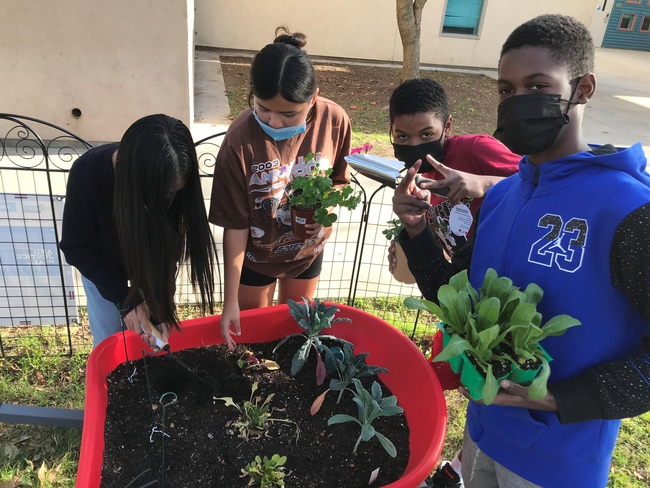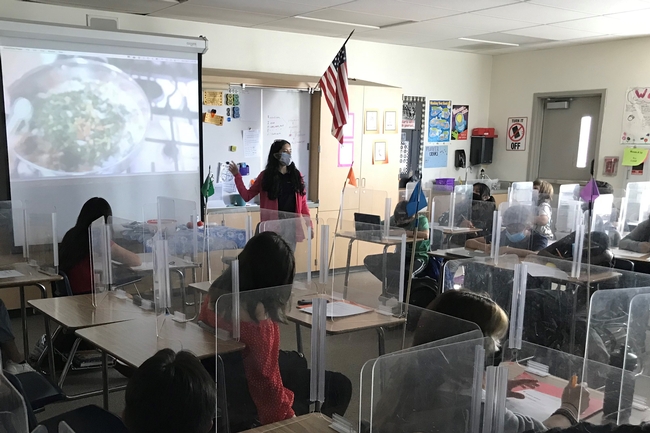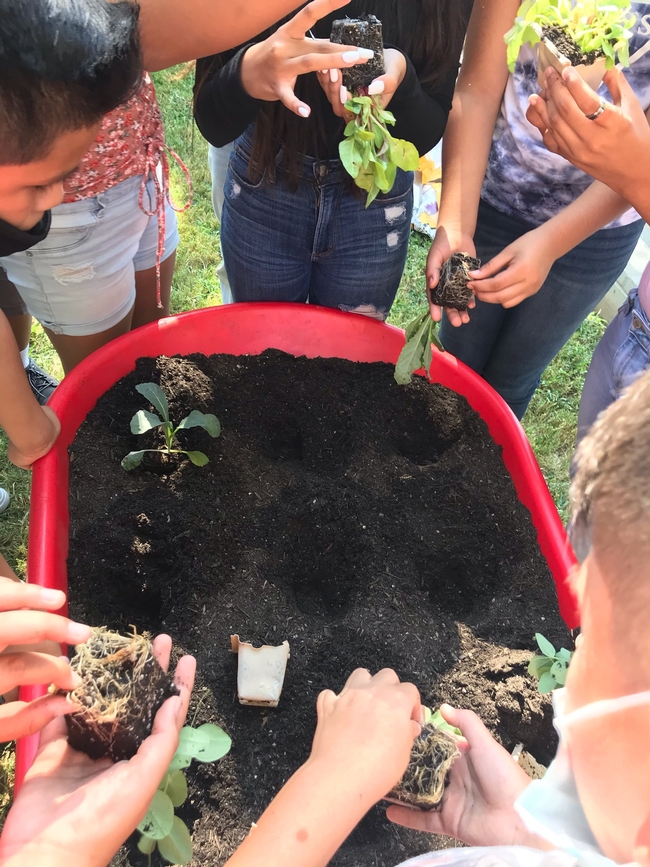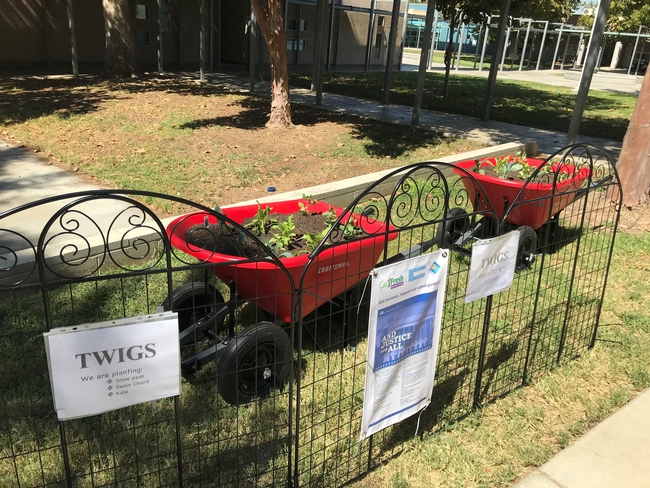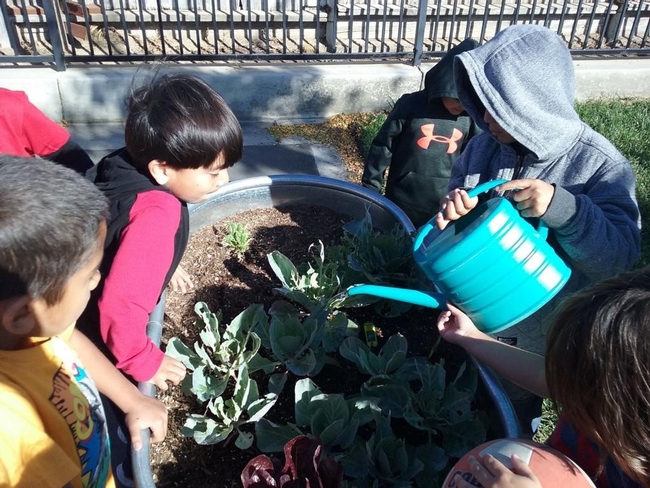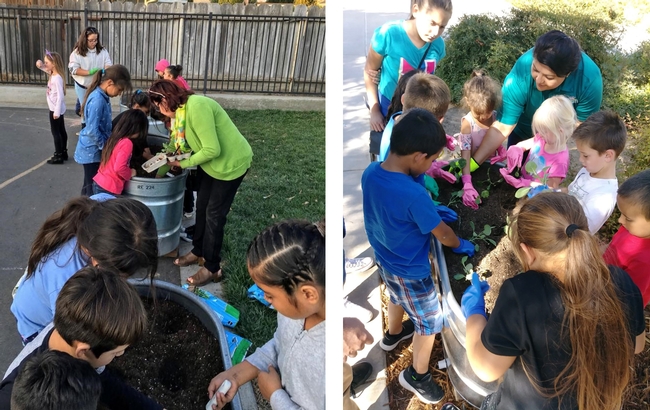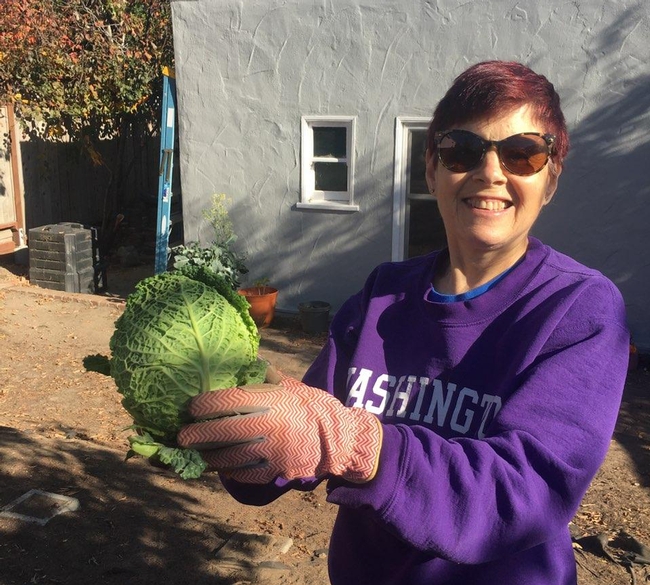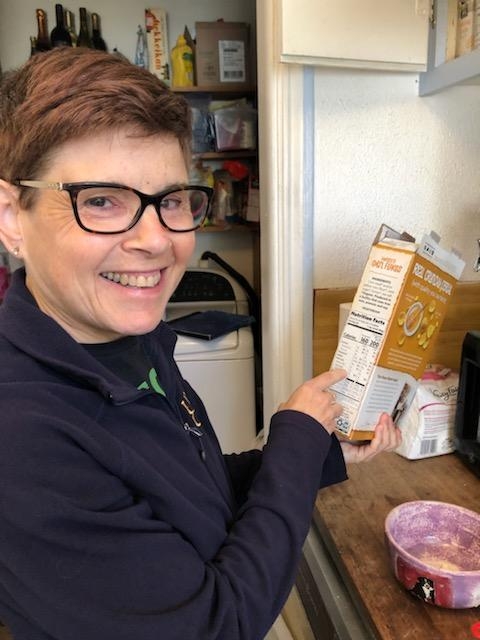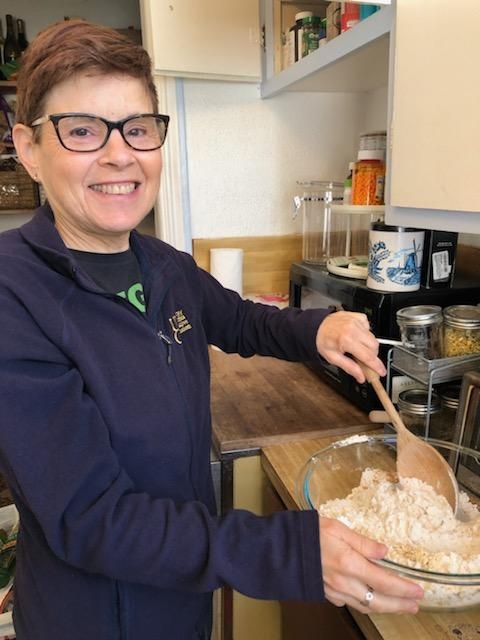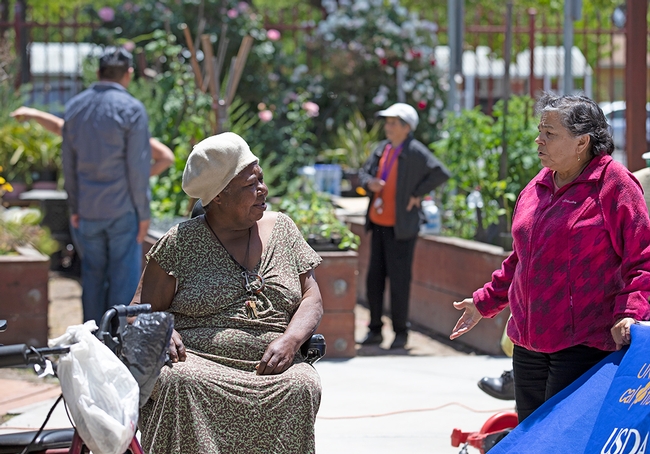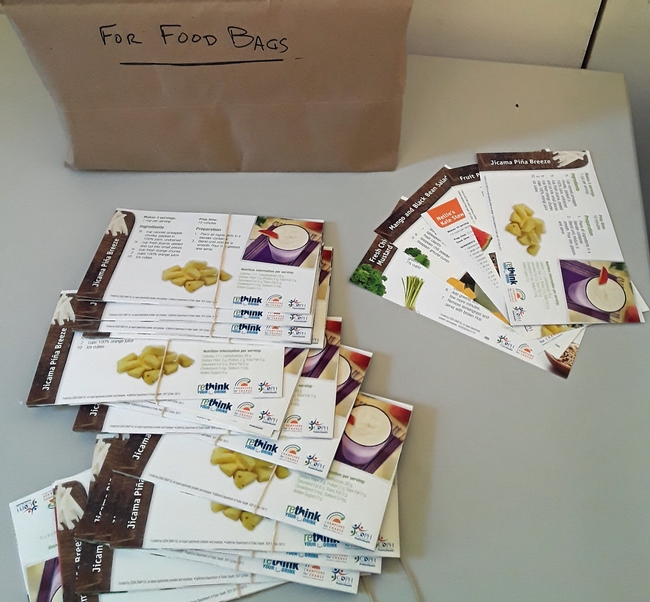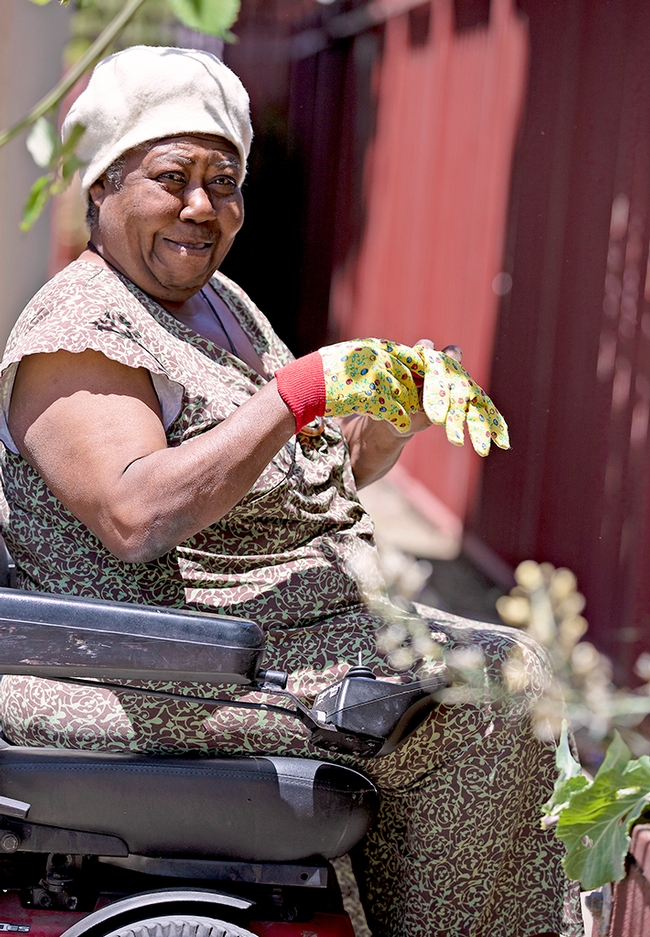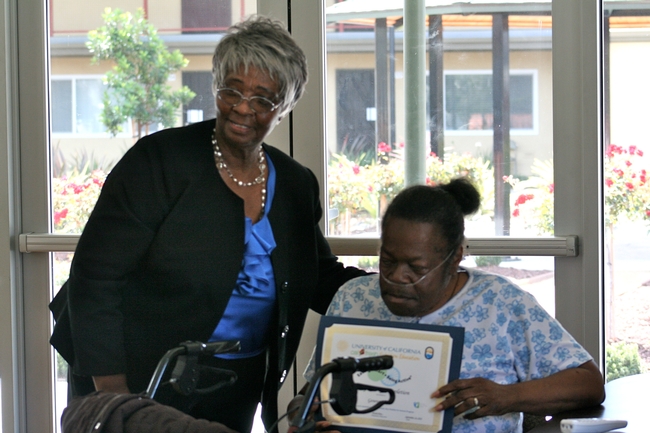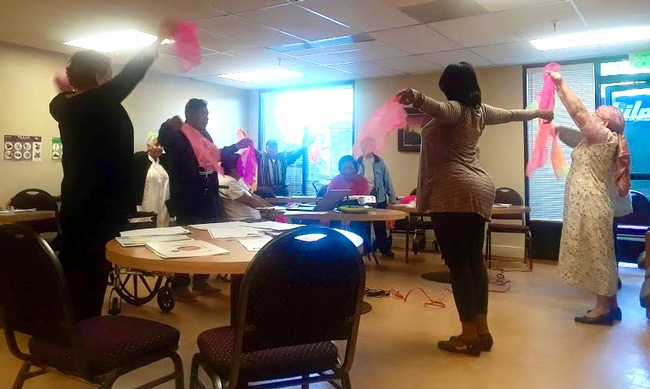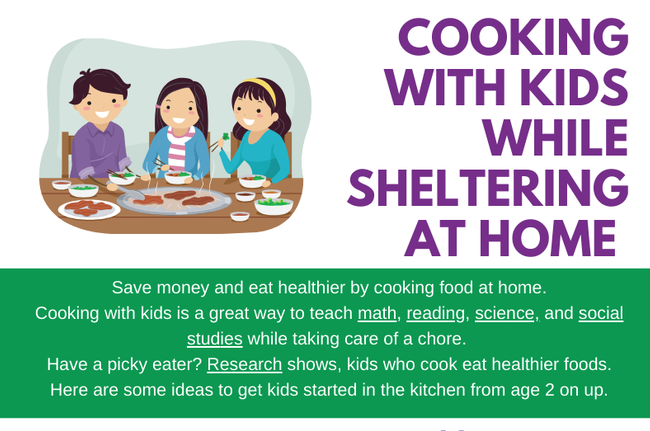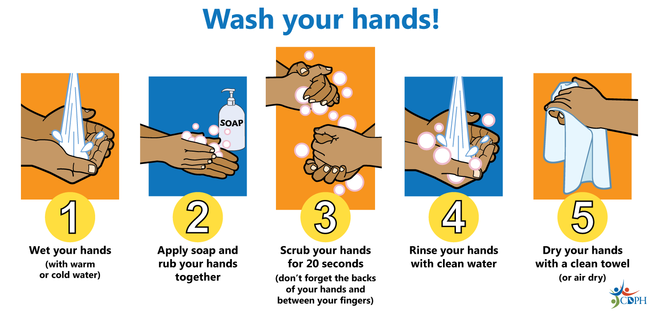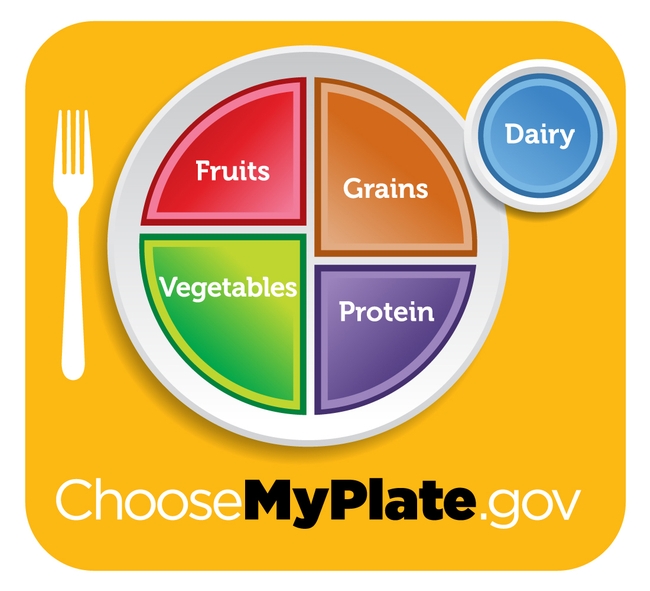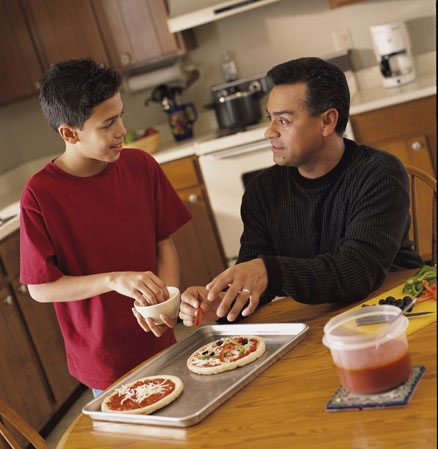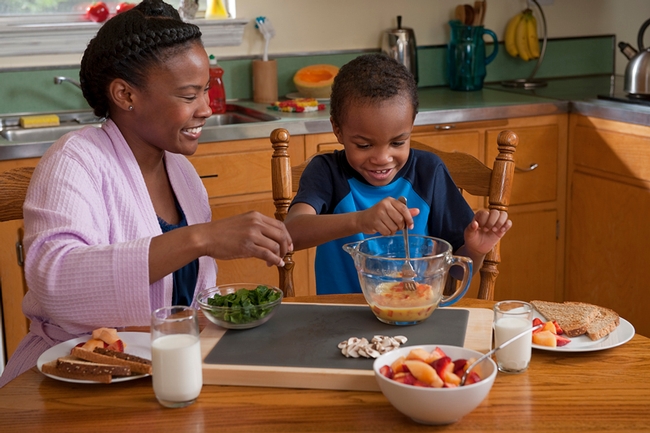Posts Tagged: CalFresh Healthy Living UC
Sixth graders nurture wheelbarrow garden, grow community connections
After harvesting and cooking their produce, students ask for seconds of kale
How do you get notoriously finicky sixth graders to eat their leafy greens? Have them grow the vegetables themselves.
Students in Riverside have that unique opportunity through a hands-on gardening and nutrition class at Ysmael Villegas Middle School, with help from CalFresh Healthy Living, University of California Cooperative Extension Riverside County (a part of UC Agriculture and Natural Resources).
“We have middle schoolers asking for seconds and thirds of kale – that's not something that's typical!” said Claudia Carlos, program supervisor for CalFresh Healthy Living, UCCE Riverside, which implements SNAP-Ed locally (the educational arm of the Supplemental Nutrition Assistance Program, formerly known as food stamps).
Growing and tending kale, mint and snap peas in two wheelbarrow gardens on the Villegas campus, the second cohort of students capped their 12-week class with a cooking lesson. A simple recipe combining their kale with tomatoes, onions and coconut milk was a big hit.
“It's one thing to tell youth they should eat healthy, but not until they actually grow the food do they actually take a lot of pride in that food they've grown and harvested,” Carlos explained.
By the end of this school year, about 75 students (in three cohorts) will have taken the class, during which they explore career pathways in gardening, agriculture and nutrition – while cultivating new skills and healthy habits such as choosing nutritious snacks and incorporating exercise into their day. Techniques developed by the UC help encourage effective behavior change.
“In this exploratory class, I've learned how to plant, and take care of plants,” wrote one student, in evaluating the class. “I can use these skills later on in life most likely, and I also learned how to be more healthy.”
Teachers observed that other students also have taken steps to apply their new skills and knowledge.
“They become more confident in themselves and their abilities to make healthy choices for themselves and their families – and to advocate for their parents to buy that kale and actually eat it,” said Daisy Valdez, community education specialist for CalFresh Healthy Living, UCCE Riverside, who is helping teach the class.
Valdez also has been training Villegas teacher Kim Weiss, so that Weiss – a first-year full-time teacher – is empowered to teach future cohorts. Both Valdez and Weiss noticed that nearly all of the youth have been enthusiastic about getting their hands in the soil, watering and weeding regularly – even taking care of the “worm hotel.”
“Students are very invested in the plants, how they are doing and their well-being,” Weiss said. “They ask if they can come back to the class and help care for the plants and worms; students worry about who will take care of the plants and worms after they leave.”
In addition to basic gardening and cooking skills, the class also incorporates lessons about herbs and spices, beneficial insects and pollinators, and cultural dimensions of food. The kale cooking lesson, which recently took place during Black History Month, presented a chance to teach about African food and culinary traditions.
“It allows them to not just connect to the garden but also to connect to their peers and to connect to the world around them,” said Valdez, who added that the garden, planted in a pair of cheerful red wheelbarrows, also beautifies the campus and sparks conversations among their schoolmates about food systems.
The Villegas partnership with CalFresh Healthy Living, UCCE Riverside also benefits the entire school in other ways, with programs reaching hundreds of students and community members. In spring 2021, under Valdez's supervision, students created a “food access board” that shows how to obtain healthy and affordable food through CalFresh EBT, farmers markets, WIC and other resources.
The board, which has been set up in the library, cafeteria and lobby, is seen and used by students and family members. Valdez also engaged parents and the broader community by hosting gardening and nutrition workshops.
This year, Villegas students will have the opportunity to further deepen their cultural connections through a new Youth Participatory Action Research project, in which they explore their personal and family histories through the lens of a meaningful and healthy food item, practice or tradition. Youth will then share their findings with school peers and administrators.
As Carlos noted, these young people will not forget such engaging and immersive experiences with food any time soon. In their evaluations, many students wrote that they learned valuable lessons about compost, care for plants and insects, and healthy eating.
And, as one sixth grader said: “I also learned that kale and coconut milk is amazing!”
CalFresh Healthy Living, UCCE educators and promotoras teach children gardening to encourage healthy eating
When local promotoras - volunteer health workers - team with CalFresh Healthy Living, UC Cooperative Extension educators, magic happens in school gardens. Trained by Ceres Partnership for Healthy Families in Stanislaus County, promotoras encourage children to eat well by growing their own produce in school gardens.
In 2018, twenty promotoras were trained to implement the Powerful People curriculum designed to engage community leaders. This is a partnership with Cultiva La Salud and Ceres Partnership for Healthy Families with funding support from Stanislaus County Health Services Agency. After the training, the promotoras worked with Ceres Unified School District to create school gardens at five Ceres elementary schools where their children attended afterschool programs that host UC Cooperative Extension CalFresh Healthy Living, UC programs.
A key initiative CalFresh, Healthy Living, UC (CFHL) offers in counties throughout the state involves growing fresh produce and making it a regular part of family diets. TWIGS: Youth Gardening and Healthy Eating Curriculum is a UC Agriculture and Natural Resources comprehensive curriculum with 16 garden lessons and 15 nutrition lessons available for free download from its website.
CFHL has teamed with promotoras in Stanislaus County since 2018 to ignite local participation in teaching children that participate in garden clubs about plant and nutrition science, from building soil to creating sumptuous salads. Two years ago, a new UCCE community education specialist was assigned to the project, Rosalinda Ruiz. A native Spanish speaker and a mother herself, Ruiz quickly developed close relationships with the promotoras.
“She's not just their teacher. They look to her as a mentor and a friend,” said Jaci Westbrook, CalFresh Healthy Living, UC Community Education Supervisor for Stanislaus and Merced counties.
Ruiz is also a certified UC Master Gardener, having completed rigorous coursework in sustainable food gardening, pest management, irrigation practices and soil health. She realized the TWIGS curriculum would reach more students if she taught the promotoras how to implement the lessons at school sites.
“This empowered the promotoras to gain knowledge and gave them a different purpose,” Westbrook said. “They don't need to rely on others to offer activities. Working in pairs or small groups, they are reaching 100 to 135 elementary school students themselves.”
Ruiz marvels at the many benefits of food gardening.
“Learning about gardening is the best thing families can do to teach their kids about healthy foods,” Ruiz said. “To grow your own food is a way to get fresh, nutritious food in your home. When kids see the fruit and vegetables growing and they're part of it, they are more willing to try it out.”
During the COVID-19 pandemic, promotoras instruction continued online using Zoom, which was completely new to them, and with WhatsApp, a familiar platform for promotoras to communicate among themselves.
The students are also getting virtual instruction. Promotoras have become proficient at Zoom and are offering simple garden lessons. Socially distanced in-person gardening lessons are also resuming to give children hands-on experience growing their own food.
Jobseekers get fresh start with JobTrain, CalFresh Healthy Living, UC
Jailene Mendoza is excited to start her new job as a medical assistant in sports medicine in Palo Alto, a job she landed after completing training with JobTrain.
After her job ended at the Housing Office at California State University, Stanislaus,Mendoza opted for training to help her move into a career that offers self-sufficiency. JobTrain provides career training in fields such as medical assistant, culinary arts, certified nursing assistant, carpentry, building maintenance, IT support and services.
For the past eight years, CalFresh Healthy Living, UC Cooperative Extension has partnered with the Menlo Park-based nonprofit to provide nutrition classes to unemployed residents of San Mateo County.
“These valuable life skills complement the vocational training they receive at JobTrain,” said Elaine Silver, nutrition educator for CalFresh Healthy Living, UCCE in San Mateo and San Francisco counties.
Based on 2018 SNAP-Education figures, 59% of all San Mateo County adults are obese or overweight and an estimated 68,000 county residents are food insecure. To address these health concerns among JobTrain students, CalFresh Healthy Living, UCCE delivers a course called “Plan, Shop, Save and Cook.”
In these lessons, JobTrain students learn about MyPlate, shopping on a budget, preparing healthy meals and snacks for families, reading food labels, and the importance of physical activity.
“CalFresh Healthy Living, University of California Cooperative Extension courses taught me and provided me with many resources,” said Mendoza, who took the course in the summer of 2020. “I am constantly using the eatfresh.org website for recipes. A handout that has really helped me is the "Eating Better on a Budget." I refer back to this because I have caught myself buying more than what is needed and it ends up going to waste.”
“I also like to watch what I eat because I have the BIGGEST sweet tooth and MyPlate has helped me out with that. I make sure I have my grains, fruits, vegetables and protein before I even consider having any type of sweets.”
Mendoza said she shared the "Eating Better on a Budget” tips with her family so they can reduce food waste.
In past years, Silver delivered the lessons in person, but switched to Zoom during COVID-19 stay-at-home orders to allow JobTrain students to continue building these important life skills.
Since October 2020, 128 JobTrain students have taken Silver's virtual Plan, Shop, Save and Cook lessons. The San Mateo County residents improved their skills in planning meals, comparing unit prices, shopping with a list, considering healthy food choices when feeding their families, and using nutrition facts labels, according to a survey conducted after the course.
“I started cooking healthier meals for my family, including veggies,” wrote one survey respondent.
Overall, 88% of the students reported improvements ranging from 43% comparing unit prices more often to 60% using nutrition facts more often. In addition, 28% of participants reported running out of food less often before the end of the month – suggesting they were more food secure after taking the course.
“Some of the changes I've made is that I now look at the unit price, just to make sure I am getting my money's worth,” wrote another student. “Also, I have started taking a grocery list with me so that I can make sure I can stay in budget and not buy things that I do not need.”
Asked about the impact these virtual classes have had on students' lives, the feedback from JobTrain instructors has been overwhelmingly positive.
“Students look forward to these classes each week, and I love to see how excited they get when they learn about new ways to incorporate healthy practices into their everyday lives,” said Emily Phillips, JobTrain culinary arts instructor, who noted Silver's food safety lessons reinforce training that she teaches people learning food preparation.
Silver also encourages JobTrain students to be physically active and to take advantage of free park passes offered by San Mateo County Public Health through their Park Rx Program. These free park passes incentivize families to spend time in nature to improve their health and well-being.
“Elaine's workshop has been very beneficial for the students at JobTrain. They utilize her suggestions on nutrition, saving techniques for food and applying healthy living for the student and their families,” said Xavier Gabut, who teaches nursing. “Elaine's workshops are relevant for my students, who will be entering the healthcare field, taking care of and educating patients on health.”
Mendoza, who earned a bachelor's degree in psychology from CSU Stanislaus, has returned to school. While working as a medical assistant in sports medicine, she will be completing her prerequisites for a degree in nursing.
Elders need food and family for the holidays
In the U.S., the holiday season of Thanksgiving, Hanukkah, Christmas, Kwanzaa, and New Year seems to be a nonstop race to the end of the year. Gathering to exchange gifts and eat special food and bountiful meals are common ways we celebrate. But the new ‘Grinch' of the season, COVID-19, prevents us from gathering with elders and other people outside of our households.
“We've asked the most vulnerable in our culture to shelter, and now they are the most isolated and most in need of seeing people,” said Kirsten Bibbins-Domingo, chair of the Department of Epidemiology and Biostatistics at UC San Francisco.
Historically, elders in many cultures have special places in the hearts of families during the holiday period of thanks, well-wishing, giving and remembering.
Elders play a major role in passing on oral family history and showing how to prepare cultural or traditional family foods, favorite recipes and other novelties handed down from one generation to the next. In contemporary society, extended-family households are rare so millions of seniors are living alone. Some elders have the financial capability and support systems to enjoy fulfilling experiences during the holidays, as much as the pandemic allows. Others will spend time lacking the basics — food, warmth and conversation.
The Centers for Disease Control and Prevention (CDC) published some considerations with tips to prevent the spread of COVID-19 throughout the season – stay home and avoid unnecessary travel. The best way to help keep friends and loved ones safe is to celebrate at home with immediate household members or connect virtually.
Seeing someone nourishes the soul
UC Cooperative Extension collaborates with local public and private community-based organizations and groups to serve senior residents.
As charter member of the Alameda County Community Nutrition Action Partnership (CNAP), inaugurated in 2006, UC Cooperative Extension coordinates with the Alameda County Health Department, Area Agency on Aging, Alameda County Social Services Agency, Alameda County Department of Education, Alameda County Food Bank and others.
During the pandemic, CalFresh Healthy Living, UC supervisor Tuline Baykal and community educators Max Fairbee and Leticia Christian continue to provide nutrition information to community members, inserting into food bags recipes, nutrition information and exercises that can be done at home. Max Fairbee, CalFresh Healthy Living, UC educator has also volunteered to deliver food bags to residents at a senior housing site.
“The food bags were hefty in the beginning, but are smaller now with less items available at the Food Bank,” observed Fairbee. “Still, they usually get some fresh produce, some canned fruit or veggies, bread, potatoes, onions, eggs (sometimes) and meat (sometimes). Spectrum Community Services also has provided emergency relief food boxes which contain non-perishable items (including canned tuna) generally once a month.”
The food bags are delivered without contact with the elders.
“We knock or ring the doorbell, announce we are dropping off food and leave it in a safe spot near their door for them,” he explained. “The seniors stay inside their homes, but they are happy and so grateful to see the volunteers and staff. I think that seeing someone actually means more to them than the food itself.”
Food and family top the holiday wish list of vulnerable seniors
In November 2020, CalFresh Healthy Living UC educators asked low-income housing site coordinators and center directors what seniors in their complexes and centers would appreciate most for the holiday season.
Their desires are very basic to daily living. The seniors suggested the following:
COVID-19 prevention: Hand sanitizer, gloves
Food: A traditional holiday meal, Safeway gift cards; fresh produce, vegetarian meal, pumpkin pie
Celebration: cookie box, fruit box, dried fruit box, nuts.
Family: Having immediate or extended family visit
Clothing: Warm blankets and warm clothing
How can we honor and assist seniors?
Consider sending meaningful holiday messages to seniors. Let the seniors in your community know it is to them we owe our lives, our survival, our respect and our gratitude.
Families and friends: Call elders living alone to ask about their well-being. Having a conversation with them in person – while standing outside their door, distanced and wearing your mask – helps keep them connected. Offer to assist them, using all COVID-19 precautions. Make time to shop for them to ensure they have their medicine and food that is safe and healthful, in small portions for one or two people, and easy to prepare or heat. See that their refrigerator is clean, set at the right temperature, and free of outdated food. They may need help putting out the garbage, cleaning and sanitizing the kitchen, and doing laundry. Let them know you are someone to call if they need immediate help.
Caregiving: Caring is the operative word. Treat seniors with patience, respect and understanding. Let them know they are worthy of the care you give.
With the COVID-19 constraints, underserved and vulnerable groups are facing an even greater crisis, especially with access to health services, housing, food and financial support. This holiday season and throughout the year, I encourage you to reach out to our elders. If you don't have money to spare, you can give emotional gifts. Your attention, conversation and compassion will be appreciated.
When COVID-19 restrictions ease, UC Cooperative Extension will resume educational activities where elders can socialize and be recognized when they participate in gardening, nutrition, physical activity and safe food handling classes. We have seen success in training elders as “wellness ambassadors” to encourage their neighbors to join our activities to address isolation and communication issues.
Home schooling during the stay at home order: Kids in the kitchen
Most people are home a lot more right now. That can mean more time spent on meal preparation for ourselves and our families. Luckily, cooking at home is a great way to save money and eat healthier. If you are feeling pressed for time, ask your kids for help in the kitchen or planning meals and grocery lists. Kids who are involved in cooking meals have been shown to have healthier diets and eat a greater variety of foods.
Is this their first time in the kitchen?
Make it fun and start with safety. Food safety is the first and most important cooking skill you can teach your kids. Show them how to wash their hands for 20 seconds. By now, many people know that singing Happy Birthday twice is about 20 seconds, but if you don't like that song or your kids are older, there are a lot of other 20-second songs or your kids can create their own at Wash Your Lyrics.
Remind children to wash the back of their hands, under their fingernails and above their wrists. Also, wearing an apron if you have one can be fun and food safe. Aprons help keep the germs and dirt from clothes out of your food, especially important if kids are changing their clothes less now that schools are not in session. Be sure to clean and sanitize any cooking surfaces before you begin food preparation.
What if your child is not interested in cooking?
Ask them what they want to eat or cook. Give them boundaries for selecting recipes that meet your needs, for example: they have to use ingredients that you already have at home, or it has to include at least three of the five MyPlate food groups. Giving youth decision-making power is a great way to ensure they are invested and engaged. Start with lunch or snack preparation then move onto dinner once they've got the basics down. Need some ideas? MyPlate snack tips for kids
Kids still not interested?
Some young people might become more interested if cooking involves learning about their family history or cultural foods. Share your food traditions and family recipes with them.
Kids can cook! How to manage your stress so cooking can be fun for everyone
Letting young ones crack an egg or mix batter can be hard to watch and messy, but it can be very empowering for a child. If you're anxious about letting them cook, they will be too and that can take some of the fun out of cooking for both of you. The first step could be acknowledging everything you're feeling about inviting a child into your kitchen. Are you worried that dinner won't be finished in time? Are you nervous about the mess that you will have to clean up? Are you concerned that they will hurt themselves or break something? Find out what is causing you to feel uneasy and acknowledge it. Once you know what you are feeling stressed or anxious about, then you can find a way to manage it.
5 things you can do to create a lower stress environment in the kitchen
- Put a towel down on the counter to make clean-up easier and bowls less prone to sliding around.
- Use a smaller bowl for the child to mix or measure ingredients in before it is poured into the larger recipe bowl.
- Consider creating a cook space outside.
- Take it one step at a time, wait to introduce cooking on the stove until they are older and you are confident in their skills and safety awareness.
- Start simple, with lower-stress meals like snacks or lunch – you can move onto dinner when you are ready.
A little time invested now, will pay off in the future
Getting kids involved in the kitchen and teaching them new skills takes time and effort. Make sure that effort pays off. Ask them to practice and perfect their skills frequently so they can help and become responsible family members. Consider adding cooking to their weekly chores. Important tasks that anyone can do to help in the kitchen include scrubbing vegetables, tearing lettuce into pieces, cleaning counters and dishes, making a grocery list, creating a meal plan, etc.
Culinary skills to start with
- Washing and picking cilantro, parsley, basil or other leafy greens. Show them the difference between the leaf and the stem. Give them a bowl or measuring cup and show them how much you need. Ask them to fill the cup/bowl.
- Stirring and mixing. Kids like to do things themselves and be in charge. Show them how to mix and give them a tool that fits in their hand – a fork makes a great sifter/mixer and there is less of an opportunity for ingredients to be scooped and flung.
- Cutting soft foods with a plastic or butter knife on a cutting board. If possible, make a flat surface on the food so that it doesn't roll around while they are trying to cut. For example, cut several strawberries in half. Lay the flat side down and have them slice the strawberries and remove the green stem. Show them how to hold the knife with the blade moving down and away from the body. Want more instruction? Video on basic knife skills
- Pushing buttons on the oven, microwave or food processor. Can they find the number 2? Can they preheat the oven to 350 degrees?
- Cracking eggs into a small bowl so that it is easy to get the shells out when they don't crack the egg perfectly the first or second or third time. Were you taught how to crack an egg? Teaching others how to cook is a great way to enhance your own skills.
Older kids and youth
- As they get older they will want even more independence and decision-making power. Let them call the shots – with guidelines. For example, let them plan a meal but tell them they need to include at least three food groups from MyPlate. This way you don't end up with fried chicken for dinner and no sides. Offer to be their assistant so you can guide and supervise.
- Show them how to read a recipe and increase their vocabulary with words like dice, chop, simmer, etc.
Need more ideas of age-appropriate cooking activities for kids? See the Cooking with Kids infographic for recipes, and links to more sources. The possibilities are endless.

